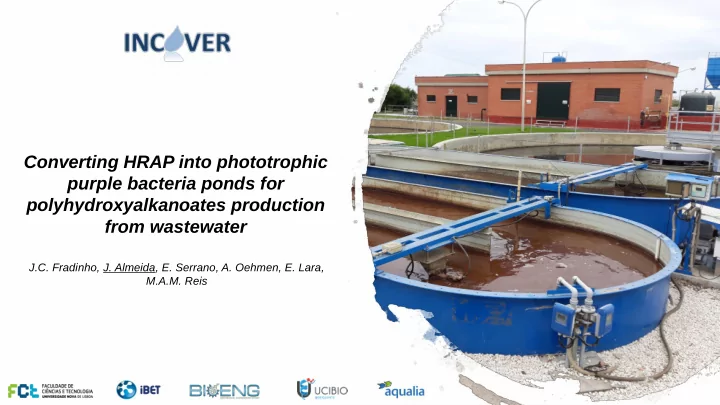

Converting HRAP into phototrophic purple bacteria ponds for polyhydroxyalkanoates production from wastewater J.C. Fradinho, J. Almeida, E. Serrano, A. Oehmen, E. Lara, M.A.M. Reis 1
PROBLEM AND SOLUTION PLASTICS PHA SOLUTION PROBLEM SUSTAINABLE PLASTIC Biodegradable ECOLOGICAL NEGATIVE Essential materials PRODUCTION PROCESSES polymer produced by IMPACT for our society microorganisms and similar Mixed microbial cultures WASTE to conventional plastics. Low cost carbon sources RESOURCES 2
SELECTION STRATEGY FEAST AND FAMINE REGIME FF strategy selects organisms for their capability of growing on the accumulated PHA PHA PRODUCTION WITH AEROBIC MIXED CULTURES Aerobic organisms: require intensive aeration 24H CONTINUOUS AERATION 24H CONTINUOUS AERATION 3
SELECTION STRATEGY FEAST AND FAMINE REGIME FF strategy selects organisms for their capability of growing on the accumulated PHA PHA PRODUCTION WITH DAYLIGHT FEAST DARK FAMINE PHOTOTROPHIC MIXED CULTURES VFAs Phototrophic organisms: ATP production independent of oxidative PHA phosphorylation NH 4 DECREASED AERATION DECREASED AERATION COSTS COSTS 4 FREE SUNLIGHT AERATION
RETROFITTING OF CHICLANA HRAP PHA production with purple bacteria using retrofitted HRAP MOLASSES RESIDUES FROM SUGAR INDUSTRY 2 PONDS: 32 m 2 /unit CLARIFIERS DOMESTIC ORGANIC WASTEWATER ACIDS RICH STREAM UASB 20 m 3 UASB Total: 18 m 3 REACTOR SCREENING 1 MM BIOMASS ENRICHED IN PHA 5
RETROFITTING OF CHICLANA HRAP UASB’s VFAs Microalgae initial MOLASSES stream Red-purple mixotrophic bacteria culture culture WASTEWATER 1 2 3 4 5 6
DEMO PONDS OPERATION FEED SOLUTION FERMENTED MIXTURE OF WASTEWATER WITH 0,5% Fluctuating Feedstock (v/v) SUGAR MOLASSES ADAPTATION PERIOD BATCH MODE Promote the growth of purple bacteria PERMANENT PRESENCE OF CARBON AND NUTRIENTS FEAST AND FAMINE Alternating presence of FEEDING REGIME carbon 24H CYCLE CIRCADIAN CYCLE AERATION IN THE NIGHT 7
DEMO PONDS OPERATION .MAY B A .MARCH 8
DEMO PONDS OPERATION N and P N and P suplementation suplementation Harvesting Harvesting 9
DEMO PONDS OPERATION BOTH PONDS WERE DOMINATED BY PURPLE BACTERIA MAXIMUM IRRADIANCE AND TEMPERATURE REGISTERED IN CHICLANA 2018 JULY JUNE POND 1: ENRICHED IN PURPLE BACTERIA POND 2: STILL PRESENTED A GREEN COLOUR 10
JULY 2018 POND 1) POND 2) 75 CmM AO+EtOH 8 PULSES OF CARBON 1.9 g VSS · L -1 1 MONTH OF 2.2 g VSS · L -1 12.5 mmolC L -1 d -1 DELAY HB:HV 35:65 HB:HV 65:35 ORGANIC ACIDS LOW PREFERENCE LIMITATION FOR VALERIC ACID 11
AUGUST 2018 POND 1) POND 2) 82 CmM AO+EtOH 7 PULSES OF CARBON 2.7 g VSS · L -1 2.3 g VSS · L -1 1 MONTH OF 11.9 mmolC L -1 d -1 DELAY HB:HV 40:60 HB:HV 70:30 LOW PREFERENCE ORGANIC ACIDS FOR VALERIC AND LIMITATION BUTYRIC ACID 12
DEMO PONDS OPERATION LOW IRRADIANCE AND TEMPERATURE REGISTERED IN CHICLANA BOTH PONDS BEHAVING SIMILARLY JULY JUNE AUGUST OCTOBER APPEARANCE OF FLOATING ALGAE THAT STAYED IN THE SURFACE AND SHADED THE UNDERNEATH ORGANISMS 13
OCTOBER 2018 POND 1) POND 2) 100 CmM AO+EtOH 6 PULSES OF CARBON 2.4 g VSS · L -1 2.0 g VSS · L -1 12.7 mmolC L -1 d -1 HB:HV 50:50 HB:HV 40:50 LOW PREFERENCE ORGANIC ACIDS FOR VALERIC AND LIMITATION BUTYRIC ACID 14
PHA PRODUCTION TARGETS 48 PERSPECTIVES g PHA/m 2 ·d FUTURE 120 0.4 g VSS/m 2 ·d g PHA/g VSS 1.5 Kg PHA/pond·d 15
CONCLUSIONS Phototrophic mixed cultures surge as a new and alternative system for mixed culture PHA production. HRAP were successfully retrofitted into Phototrophic Purple Bacteria Ponds (PPBPonds). With PPBPonds the high cost with aeration that typically occur in aerobic systems during the feast phase are eliminated. PPBPonds require only minimal aeration during the famine/night phase. PHA contents up to 30% were achieved, a value that is expected to increase with: Higher organic carbon load Favourable influent acid composition. 16
Acknowledgments Financial support: • European Research Council (ERC) H2020 INCOVER projects Thank you all for your attention! http://sites.fct.unl.pt/bioeng/home
Recommend
More recommend